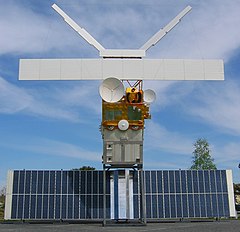Technology: What is Satellite? How Satellites Work?
In the context of spaceflight, a satellite is an object which has been placed into orbit by human endeavour. Such objects are sometimes called artificial satellites to distinguish them from natural satellites such as the Moon.
A full-size model of the Earth observation satellite ERS 2
The world's first artificial satellite, the Sputnik 1, was launched by the Soviet Union in 1957. Since then, thousands of satellites have been launched into orbit around the Earth. Some satellites, notably space stations, have been launched in parts and assembled in orbit. Artificial satellites originate from more than 50 countries and have used the satellite launching capabilities of ten nations. A few hundred satellites are currently operational, whereas thousands of unused satellites and satellite fragments orbit the Earth as space debris. A few space probes have been placed into orbit around other bodies and become artificial satellites to the Moon, Mercury, Venus, Mars, Jupiter, Saturn, and the Sun.
Satellites are used for a large number of purposes. Common types include military and civilian Earth observation satellites, communications satellites, navigation satellites, weather satellites, and research satellites. Space stations and human spacecraft in orbit are also satellites. Satellite orbits vary greatly, depending on the purpose of the satellite, and are classified in a number of ways. Well-known (overlapping) classes include low Earth orbit, polar orbit, and geostationary orbit.
Satellites are usually semi-independent computer-controlled systems. Satellite subsystems attend many tasks, such as power generation, thermal control, telemetry, attitude control and orbit control.
Types of Satellite
- Anti-Satellite weapons/"Killer Satellites" are satellites that are designed to destroy enemy warheads, satellites, and other space assets.
- Astronomical satellites are satellites used for observation of distant planets, galaxies, and other outer space objects.
- Biosatellites are satellites designed to carry living organisms, generally for scientific experimentation.
- Communications satellites are satellites stationed in space for the purpose of telecommunications. Modern communications satellites typically use geosynchronous orbits, Molniya orbits or Low Earth orbits.
- Miniaturized satellites are satellites of unusually low masses and small sizes.[13] New classifications are used to categorize these satellites: minisatellite (500–100 kg), microsatellite (below 100 kg), nanosatellite (below 10 kg).
- Navigational satellites are satellites which use radio time signals transmitted to enable mobile receivers on the ground to determine their exact location. The relatively clear line of sight between the satellites and receivers on the ground, combined with ever-improving electronics, allows satellite navigation systems to measure location to accuracies on the order of a few meters in real time.
- Reconnaissance satellites are Earth observation satellite or communications satellite deployed for military or intelligence applications. Very little is known about the full power of these satellites, as governments who operate them usually keep information pertaining to their reconnaissance satellites classified.
- Earth observation satellites are satellites intended for non-military uses such as environmental monitoring, meteorology, map making etc. (See especially Earth Observing System.)
- Tether satellites are satellites which are connected to another satellite by a thin cable called a tether.
- Weather satellites are primarily used to monitor Earth's weather and climate.
- Recovery satellites are satellites that provides a recovery of reconnaissance, biological, space-production and other payloads from orbit to Earth.
- Manned spacecraft (spaceships) are large satellites able for put human into (and beyond) an orbit, being on it and recovery back to Earth. Spacecrafts, and orbital parts-spaceplanes of reusable systems also, has a major propulsion or landing facilities, and often uses as transport to and from the orbital stations.
- Space stations are man-made orbital structures that are designed for human beings to live on in outer space. A space station is distinguished from other manned spacecraft by its lack of major propulsion or landing facilities. Space stations are designed for medium-term living in orbit, for periods of weeks, months, or even years.
How Satellites Work
Watch video of How Satellites Work:
How Satellites Work
Read more...
If you like this post, please subscribe below,thanks!








